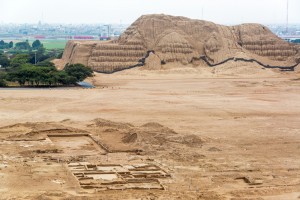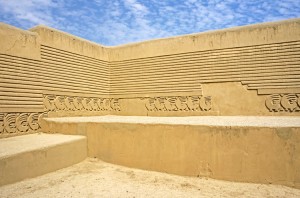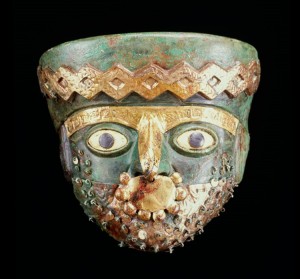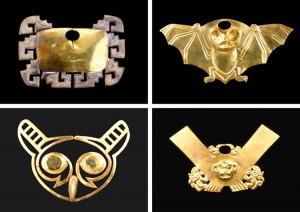The Children of Huanchaquito
Friday, May 11th, 2018May 11, 2018
At the end of April, Archaeologists in Peru published shocking details about an ancient site where more than 140 children were ritually killed in a human sacrifice ceremony about 550 years ago. Archaeologists consider the site, built by the Chimú culture on Peru’s northern coast, as evidence of the largest single mass child sacrifice in pre-Columbian history (the period before the arrival of Columbus in America). The site, which also includes the remains of more than 200 sacrificed llamas, is in Huanchaquito, a town near the city of Trujillo.

The remains of sacrificed children and animals were found near the ruins of the ancient city of Chan Chan, seen here before the modern buildings of Trujillo in the background. Credit: © Jess Kraft, Shutterstock
The Chimú were one of several civilizations that developed in what is now Peru beginning around 2800 B.C. The Chimú built a large capital city called Chan Chan. It was begun about A.D. 1000. Chan Chan’s ruins cover about 8 square miles (20 square kilometers) outside the present-day city of Trujillo. Experts in pre-Columbian history know that sacrifices and offerings were important in the religious ceremonies of many peoples, including the Chimú. People often sacrificed crops and animals to ensure adequate rainfall and fertile soil. Human sacrifices were made under certain circumstances, and numerous individual graves of sacrificed children have been found. The remains of the Chimú children of Huanchaquito, however, represent the first evidence of sacrifice on such a large scale. Archaeologist believe the mass child sacrifice must have been performed during a time of terrible crisis, perhaps caused by a natural disaster.

Richly decorated walls line the ruins of the Chimú capital of Chan Chan. The Chimú people were among Peru’s early inhabitants. Credit: © Christopher Howey, Dreamstime
The ceremonial site at Huanchaquito was discovered by archaeologists in 2011 as they were investigating the remains of an early Chimú temple. Archaeologists called the site Huanchaquito las Llamas because they found the skeletal remains of several llamas that had been killed as a religious sacrifice. Radiocarbon dating of remains indicated that the sacrifice occurred around A.D. 1400 to 1450. However, many ancient human remains were then also found at the site. As excavations continued, the number of human skeletal remains totaled 140 individuals. The researchers were shocked to discover that the skeletal remains were all from children aged 5 to 14. Most were between 8 and 12 years old. The llamas were young too, all less than 18 months old.
Other evidence showed that the children all died together as part of a mass human sacrifice. Forensic anthropologists observed cut marks on many of the bones. Such marks show the children were intentionally killed by other people and that they were not victims of a flood, earthquake, or other calamity. Especially telling were cut marks found on the sternum (breastbone) of many victims, along with damage to their ribs. This is evidence that the victims had their chests cut open and their hearts were violently removed. Traces of powdered cinnabar, a red mineral pigment often used in religious ceremonies, were also discovered among the bones of the child victims. The Chimú children were buried facing west toward the nearby Pacific Ocean. The llamas killed at the site were buried facing east toward the Andes Mountains. Archaeologists believe the children and animals were killed as part of the same ritual.
Archaeologists observed that the sacrifice victims were buried beneath a layer of fine mud. This evidence suggests a severe flood at the time in the otherwise arid (dry) region, perhaps caused by an unusually powerful weather event known as El Niño. In the late 1400’s, within a few decades of this mass child sacrifice, the Chimú were conquered by the expanding Inca civilization.
Before Huanchaquito, the largest known mass child sacrifice event was at the Templo Mayor in the ancient Aztec capital of Tenochtitlán (modern-day Mexico City), where the remains of 42 children were found.




